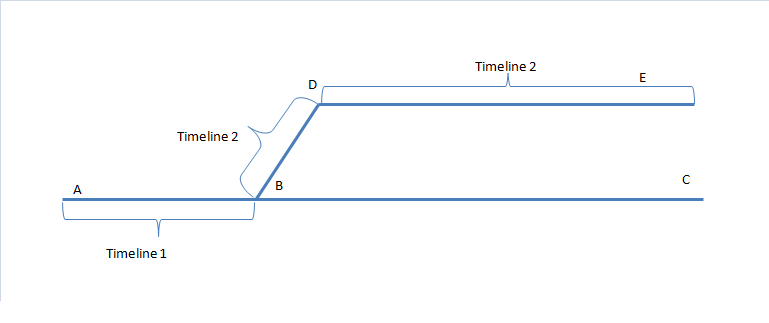PostgreSQL timeline
磨砺技术珠矶,践行数据之道,追求卓越价值
回到上一级页面: PostgreSQL基础知识与基本操作索引页 回到顶级页面:PostgreSQL索引页
关于timeline,有如下的说法
http://www.postgresql.org/docs/current/static/continuous-archiving.html
24.3.. Timelines The ability to restore the database to a previous point in time creates some complexities that are akin to science-fiction stories about time travel and parallel universes. For example, in the original history of the database, suppose you dropped a critical table at :15PM on Tuesday evening, but didn't realize your mistake until Wednesday noon. Unfazed, you get out your backup, restore to the point-in-time 5:14PM Tuesday evening, and are up and running. In this history of the database universe, you never dropped the table. But suppose you later realize this wasn't such a great idea, and would like to return to sometime Wednesday morning in the original history. You won't be able to if, while your database was up-and-running, it overwrote some of the WAL segment files that led up to the time you now wish you could get back to. Thus, to avoid this, you need to distinguish the series of WAL records generated after you've done a point-in-time recovery from those that were generated in the original database history. To deal with this problem, PostgreSQL has a notion of timelines. Whenever an archive recovery completes, a new timeline is created to identify the series of WAL records generated after that recovery. The timeline ID number is part of WAL segment file names so a new timeline does not overwrite the WAL data generated by previous timelines. It is in fact possible to archive many different timelines. While that might seem like a useless feature, it's often a lifesaver. Consider the situation where you aren't quite sure what point-in-time to recover to, and so have to do several point-in-time recoveries by trial and error until you find the best place to branch off from the old history. Without timelines this process would soon generate an unmanageable mess. With timelines, you can recover to any prior state, including states in timeline branches that you abandoned earlier. Every time a new timeline is created, PostgreSQL creates a "timeline history" file that shows which timeline it branched off from and when. These history files are necessary to allow the system to pick the right WAL segment files when recovering from an archive that contains multiple timelines. Therefore, they are archived into the WAL archive area just like WAL segment files. The history files are just small text files, so it's cheap and appropriate to keep them around indefinitely (unlike the segment files which are large). You can, if you like, add comments to a history file to record your own notes about how and why this particular timeline was created. Such comments will be especially valuable when you have a thicket of different timelines as a result of experimentation. The default behavior of recovery is to recover along the same timeline that was current when the base backup was taken. If you wish to recover into some child timeline (that is, you want to return to some state that was itself generated after a recovery attempt), you need to specify the target timeline ID in recovery.conf. You cannot recover into timelines that branched off earlier than the base backup.
经过我的实验,发现是这样的,一旦开始第一次的restore,那么就产生了一个交叉点,于是"平行宇宙"诞生了。但是还有一个问题:
参见下图:

如果我当初在A点与B点之间插入数据,又在B点和C点之间插入数据。
然后,在B点所在的时间点处Restore,那么,Timeline2就产生了。
我可以接着在B点和D点至今插入数据,又在D点和E点之间插入数据。
可以说A到B是 timeline2, B到D到E是timeline1。
到达了D点或E点后,我是无法再次Restore到 B点和C点之间了。
这是因为:
B点到C点已经成为不存在了。
(虽然所有的archive wal log我都有,但是某些数据是保留在online wal log中,这部分的数据变化,经过timeline2的处理后,其实是永远失去了)
回到上一级页面: PostgreSQL基础知识与基本操作索引页 回到顶级页面:PostgreSQL索引页
磨砺技术珠矶,践行数据之道,追求卓越价值
PostgreSQL timeline的更多相关文章
- replication_slot and PostgreSQL Replication
主库IP:192.168.230.128 备库IP:192.168.230.129 PostgreSQL版本: 主备机PostgreSQL源码包均位于/opt/soft_bak OS:CentOS5 ...
- PostgreSQL Cascade Replication
PostgreSQL Cascade Replication node1:master:10.2.208.10:repclia(user) node2:upstreamnode:10.2.208.11 ...
- PostgreSQL Replication之第十五章 与Walbouncer 一起工作
与Walbouncer 一起工作 在本书的最后一章,将引导您通向2014年发布的一个工具,称为walbouncer.本书中的大多数技巧说明了如何复制整个数据库实例,如何分片,等等.在最后一章,是关于w ...
- PostgreSQL 同步复制(1master+2standby)
OS: Red Hat Enterprise Linux Server release 6.5 (Santiago) PostgreSQL: postgresql-9.4.5.tar.bz2 mast ...
- postgreSQL 时间线
“时间线”(Timeline)是PG一个很有特色的概念,在备份恢复方面的文档里面时有出现.但针对这个概念的详细解释却很少,也让人不太好理解,我们在此仔细解析一下. 时间线的引入 为了理解引入时间线的背 ...
- UNDERSTANDING POSTGRESQL.CONF: CHECKPOINT_SEGMENTS, CHECKPOINT_TIMEOUT, CHECKPOINT_WARNING
While there are some docs on it, I decided to write about it, in perhaps more accessible language – ...
- postgresql如何维护WAL日志/归档日志
WAL日志介绍 wal全称是write ahead log,是postgresql中的online redo log,是为了保证数据库中数据的一致性和事务的完整性.而在PostgreSQL 7中引入的 ...
- PostgreSQL数据库单机扩展为流复制
primary:10.189.102.118 standby:10.189.100.195 1. 配置ssh互信机制 在primary主库执行 $ ssh-keygen -t rsa $ cp ~/. ...
- PostgreSQL主备流复制机制
原文出处 http://mysql.taobao.org/monthly/2015/10/04/ PostgreSQL在9.0之后引入了主备流复制机制,通过流复制,备库不断的从主库同步相应的数据,并在 ...
随机推荐
- springMVC入门-05
接着上一讲,介绍如何查询单个数据,此处介绍show()方法的实现.显示单条数据需要使用Users对象中的一个字段作为入参来进行对象查询,将查询出来的数据放在Model中,并且将model中的user对 ...
- 水晶报表自定义纸张大小打印 (Crystal Report Print with custom paper size)
System.Drawing.Printing.PrintDocument doc = new PrintDocument(); doc.PrinterSettings.PrinterName = & ...
- KHFlatButton
KHFlatButton https://github.com/kylehorn/KHFlatButton 效果: 对于自己做demo来说,每次设置button就不用这么折腾了,几句话就行了,非常爽: ...
- Python学习---xml文件的解析[beautifulsoup4模块学习]
1.1. 安装beautifulsoup4 pip install beautifulsoup4 [更多参考]https://blog.csdn.net/sunhuaqiang1/article/de ...
- Linux 文件的读写执行权限的说明
文件的读写执行权限的说明 X 进入目录的权限: cd 1.文件本身是可执行的 2.普通用户还具备r的权限 3.root用户只需要有r的权限即可 r 查看目录/文件的内容 :ls dir 没有读的权 限 ...
- pt1000测温度
本设计使用的PT1000热电阻铂热电阻,它的阻值会随着温度的变化而改变.PT后的1000即表示它在0℃时阻值为1000欧姆,在300℃时它的阻值约为2120.515欧姆.它的工业原理:当PT1000在 ...
- SAP CX Upscale Commerce : SAP全新推出的电商云平台
大家好,我是Andy Chen,是SAP成都研究院年轻的SAP CX Upscale Commerce (后面将会以Upscale简称)开发团队的一名产品经理.CX的全称是Customer Exper ...
- SQL Server 中的排名函数与使用场景
1.RowNumber() Over (oder by.....) 在需要对某个不连续ID的表进行排序时使用 2.ROW_NUMBER() over(PARTITION by ...... ord ...
- Hadoop HA on Yarn——集群配置
集群搭建 因为服务器数量有限,这里服务器开启的进程有点多: 机器名 安装软件 运行进程 hadoop001 Hadoop,Zookeeper NameNode, DFSZKFailoverContro ...
- angularjs-$location
$location服务分析浏览器地址栏中的URL(基于window.location),让我们可以在应用中较为方便地使用URL里面的内容.在地址栏中更改URL,会响应到$location服务中,而在$ ...
